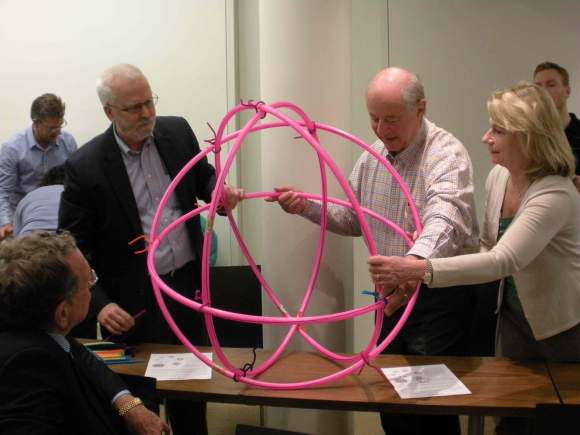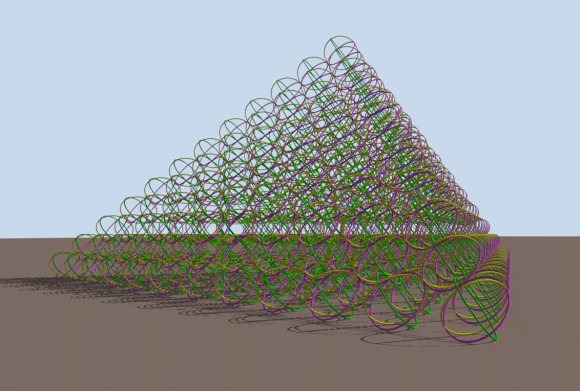Math Monday: Hula Hoop Geometry, Part 1
by Glen Whitney
Math Mondays have so far featured a wide array of different items from which one can make a tremendous variety of geometric constructions, but there has not yet been one on hula hoops. This week and next we’ll remedy that oversight. Also, the postings so far have almost entirely shown the constructions as fait accompli, so this series will also try to give a bit of insight into the process of devising a new creation.
First, why hula hoops? They’re a pretty cheap source of large, pre-made circles, generally decently symmetric and strong. So they’re a candidate for any large-scale building project that can be based on the geometry of a circle. What are some examples? Well, you can envision each circle as a great circle on a sphere, and ask: is there a way to arrange four of these so that every intersection point between great circles is equidistant from its nearest neighbors? That leads to a pleasant construction something like this:

Assignment: can you do the same thing with six hula hoops?
For a recent event, MoMath wanted a large-scale public construction activity, so based on our success with hula hoops to date, designer Tim Nissen envisioned a gigantic pyramid of hoops — here’s the initial conception:

Now that’s a lot of hoops, so we decided to try a Sierpinski tetrahedron instead of a solid pyramid, which is at least as mathematically cool and requires significantly less material. (It’s interesting to think about just how much less…) All good building events require a rehearsal, so a bunch of folks got together to try tying hula hoops together on a Sunday afternoon.
The initial tie of four hoops into a sort of truncated tetrahedron went well, as well as combining four of these into an order-1 Sierpinski tetrahedron, as you can see from the following photo. It’s interesting to note that when you attach four solid tetrahedra at the vertices to create an order-one Sierpinski tetrahedron, the cavity remaining is a different shape (what shape?) — whereas in this construction based on circles, the central void is identical to the four units that were combined.

We even managed to combine four of the order-1 units into an order-2 tetrahedron pretty nicely:

Note at the next stage, the order-2 tetrahedra were too tall for us to put one atop three directly, so we planned to put this order-2 atop three order-1 tetrahedra, one at each corner, and then lift that entire structure atop three “bases”, each formed of three order-1 tetrahedra. However, we never got that far: when we fastened the order-2 tetrahedron atop the three order-1s, here’s what happened:

Total structural collapse, leading to hula chaos! What to do?
To be continued…
This article first appeared on Make: Online, June 4, 2012.